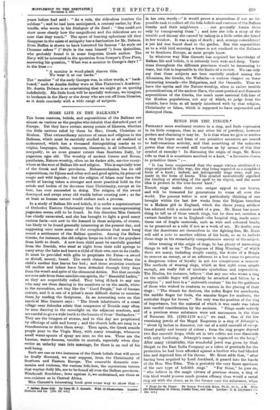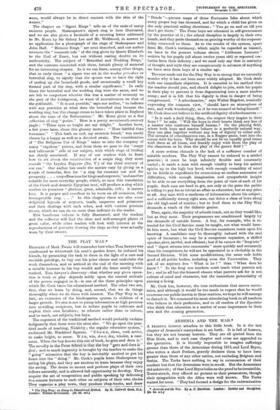RINGS FOR THE FINGER.* PROBABLY more sentiment centres in a
ring, and finds expression in its little compass, than in any other bit of jewellery, however perfect and charming it may be. Is it that when we give or receive a ring the hopes and fears of our primitive ancestors are roused to half-conscious activity, and that something of the unknown power that they revered still touches us by means of this tiny symbol of eternity ? In discussing the origin of rings, Mr. Kunz tells us that it is sometimes ascribed to a knot, " a favourite charm in primitive times " :—
" It has been conjectured that the magic virtues attributed to rings originated in this way, the ring being regarded as a simplified form of a knot ; indeed, not infrequently rings were, and are, made in the form of knots. This symbol undoubtedly signified the binding or attaching of the spell to its object, and the armor idea is present in the true-lovers' knot."
Trench rings make their own unique appeal to our hearts, and will be treasured for generations to come all over the world. The present writer is now particularly thinking of one brought within the last few weeks from the Belgian trenches to a Mathias girl in England, which the clever young artificer has adorned with a minute model of a gun. Mr. Kunz has bone- thing to tell us of these trench rings, but he does not mention a variant familiar to us in England—the hospital ring, made SOn19- times out of fragile materials, surd, as wire and coloured beads, to be preserved as a relic if not as a work of art. No doubt, now that the Americans are themselves in the fighting-line, Mr. Kurtz will add a note to another edition of his book, so as to indicts these rings in his remarkably comprehensive survey of the subject.
After treating of the origin of rings, he has plenty of interesting things to tell us on "The Purposes of Ring Wearing," of which there are many, including simple vanity, the desire of a Borgia to remove an enemy, or of an adherent to a lost cause to preserve a dangerous token of loyalty in not too conspicuous a manner. The methods of wearing rings, which at first sight seem simple enough, are really full of intricate symbolism and superstition. The Hindus, for instance, believe " that any one who wears a ring on the middle finger will probably be attacked and bitten by a scorpion " ; and here is a " sixteenth-century " list for the guidance of those who wished to conform to custom in the placing of their rings " The thumb for doctors, the index finger for merchant)), the middle finger for fools, the annular finger for students, the auricular finger for lovers." Not only was the position of tho ring of importance, but the material of which it was made was taken into careful consideration by the ancients. " Rings made entirely of a precious stone substance were not uncommon in the time of Ramesee III. (12021170 n.o.)," we read. One of the few remaining jewels of the Mogul Emperors is a ring of Jelrangir's, " about 11 inches in diameter, cut out of a solid emerald of excep- tional purity and beauty of colour ; from the ring proper depend two fine emerald drops, while set in two collets are rose diamonds with ruby bordering. Jehangir's name Is engraved on the hoop." After many vicissitudes, this wonderful jewel was given by Shah Shujah to the East India Company as a token of gratitude for the protection Ile had been afforded against a brother who had blinded him and deprived him of his throne. Mr. Kautz adds that, " after
having been acquired by Lord Auckland, it passed into the hands of the Hon. Miss Eden. This is probably the very finest apecimen of the rare type of hololith rings." "For those," he goes on, " who believe in the magic virtues of precious atones, a ring of this kind would possess mush greater efficacy than would a metal ring set with the atone, as in the former case the substance, when
Row joe fa, Finger. ne George Frederick 'Kunz, Ph.D., Se.D., A.M. With 290 Illusteatioin In Colour, Double Toss, sad lase. London: B. LIppluent en. 28s. set.]
worn, would always be in direct contact with the skin of the wearer."
The chapter on " Signet Rings " tells us of the seals of many eminent people. Shakespeare's signet ring is hero illustrated, and we are also given a facsimile of a covering letter addressed to Mr. Kunz by Sir Sidney Lee and Mr. Wellstood, in answer to an application for a photograph of the rings of Shakespeare and John Hall. " Historic Rings " are next described, and our author recounts the " romantic tale " of the ring given by Queen Elizabeth to the Earl of Essex, but not without casting doubts on its authenticity. The subject of " Betrothal and Wedding Rings," and the customs connected with them, furnish plenty of material for an interesting chapter. In it we can learn, among other things, that in early times " a signet was sot in the females promebus or betrothal ring, to signify that the spouse was to have the right of waling up the household goods, and occasionally a small key formed part of the ring, with a similar significance." In early times the betrothal and the wedding ring were the same, and we are left to conjecture whether this was a matter of economy on the part of the bridegroom, or want of inventiveness on that of the goldsmith. " It is not possible," says our author, " to indicate with any precision at what date the betrothal ring became the wedding ring, but this change seems to have taken place in England about the time of the Reformation." Mr. Runs gives us a fine collection of ring " posies." Here is a pretty seventeenth-century jingle : "Thine eyes so bright aro my delight." Another lover, few years later, chose this gloomy motto " More faithful than fortunate." " This hath no end, my sweetest, friend," was surely chosen by a happy as well as a devoted swain. The consideration of " The Religious Use of Rings " takes us into the company of many " orgulous " priests, and from them we pass to the "magic said talismanic " side of our subject, with which rings of healing are closely associated. If any of our readers wish to learn bow to act about the construction of a magic ring, they must consult " the Leyden Papyrus (No. V.) of the third century of our era." Our author has made the matter easy by giving us a couple of formulas, first for " a ring for constant use and for prosperity . . . very efficacious for kings and emperors," and another suitable for more everyday people, which, so runs this translation of the Creek and demotic Egyptian text, will produce a ring which renders its possessor " glorious, great, admirable, rich ; it insures love. It is proper and excellent to be worn on all occasions, this incomparable ring. . . ." In this chapter there are also some delightful legends of serpents, toads, emperors and princesses and their dealings with each other, and with various precious stones, which we can do no more than indicate to the reader.
This handsome volume is fully illustrated, and the student and the collector will find the clear and well-arranged plates of great value, while other readers will look with interest at the reproductions of portraits showing the rings as they were actually worn by their owners.















































 Previous page
Previous page